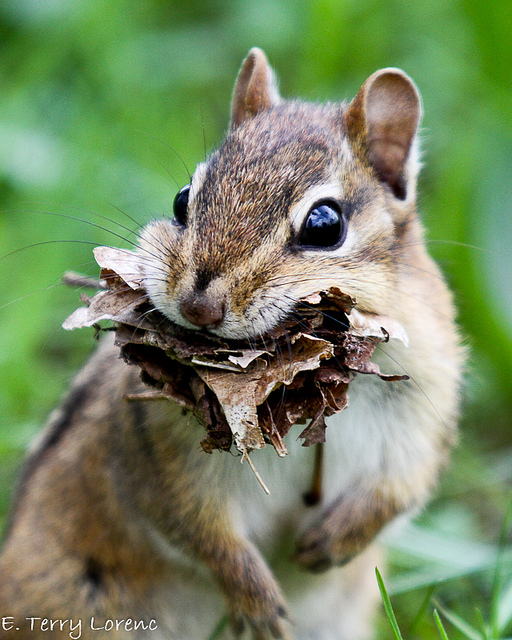These unusually warm fall days are wonderful for outdoor rambles. Nothing seems to be in a hurry, not even summer. It still seems to have a hold on October. These beautiful days can almost convince us that winter’s white cold is ages away and we have all the time in the world to prepare. It was on one such day I went for a walk in the woods. The wind, the birds, the woods were still.
Then, around the corner, as the habitat transitioned from swamp to forest there was such a commotion it stopped me in my tracks. There was constant rustling in the freshly fallen leaves, as if the forest floor was alive. Scratching, clawing, climbing up trees. And plunk, plunk, plunk as something small and hard fell, or was dropped, from the trees.
Chipmunks.
How many of us have turned sharply around while in the woods expecting a medium to large animal moving in our presence only to find it was a chipmunk? The sound of one chipmunk scurrying along the forest floor is louder than it seems it should be. But on this day, I conservatively estimated there were at least 15 chipmunks in view. Their almost constant motion made it difficult to count. These small mammals were not fooled by the laziness of the warm day. They were quite busy preparing for winter weather.
The trees they were rushing up and down were red oak trees, the furrowed bark being ideal for these small rodents to gain traction on in their journey to the top. For the top was full of acorns. Acorns and acorn tops were the small, hard items plunk, plunk, plunking on the ground as chipmunks gathered their store for the colder days ahead.

Chipmunks use pouches in their cheeks to carry food. They also carry leaves into their underground tunnels to use as nesting material. Photo by Terry Lorenc.
There are 25 species of chipmunk, across North America and the corresponding latitude in Europe and Asia. The Eastern Chipmunk (Tamias striatus) is one species found here its name meaning “striped storer.”
And store they do. Better than some humans store canned and dehydrated goods for disaster preparation. Really, each fall, it is like their world ends. The seasons change, the forest changes. Chipmunks must change too. They don’t go into true hibernation for the winter so they don’t bulk up with layers of fat as groundhogs do. In their complex, underground tunnels with dens, pantries of hoarded food and drainage holes, chipmunks have a relatively safe and well-stocked place to spend the winter.
They do go into a state of torpor in which their body functions such as breathing and heart rate slow to conserve energy. The length of this “sleep” varies quite a bit but can last one to eight days. On sunny winter days, they may venture out of their burrows to forage for food, leaving little footprints in the snow.
And to carry all that food to store, chipmunks are equipped with the ideal, if not slightly slimy, grocery bags. Their cheeks can expand to carry food, leaving their paws free for travel. Observers reported to the Pennsylvania Game Commission witnessing separate chipmunks carrying a total of 31 corn kernels, another 32 beechnuts, and a third 70 sunflower seeds in the cheek pouches.
Chipmunks are loved by children. It is easy to see why. They are quite cute with tiny ears atop their pointy head; their furry, striped body sometimes perched on hind legs; their cheeks often bulging with food, leaves or dirt.
But they are also a pest, despised by birders and homeowners. As omnivores, they eat both animals as well as plants. And their menu of foods is long. Throughout the year chipmunks eat a variety of plant material including apples, peaches, pears, berries, mushrooms and our garden vegetables. They will also take advantage of bird eggs, hatchlings, and seeds. Their tunnels can be unattractive or damaging in our human built spaces. I get it. They are often unwanted.
But chipmunks are also accessible. In a world where so many things are pulling us away from connecting with nature I find it hard to denounce something that so many children – and adults — can connect to. They are easy to find. While a deciduous forest is their habitat of choice, chipmunks have adapted well to farms, brushy areas, city parks and gardens. And they are easy to observe in these locations, often right outside the window.
Just as chipmunks consume a variety of food, they are also consumed. Hawks, mink, weasels, foxes, bobcats, house cats, raccoons, snakes and more prey on chipmunks. Whether we like them or not, they fit into a larger web of survival.
Audubon Community Nature Center builds and nurtures the connections between people and nature. The trails are open for hiking or skiing from dawn to dusk and the Nature Center is open from 10:00 a.m. – 4:30 p.m. daily except Sundays when it opens at 1:00 p.m. Visit auduboncnc.org for more information or call (716) 569-2345.
Katie Finch is a naturalist at ACNC.


Recent Comments